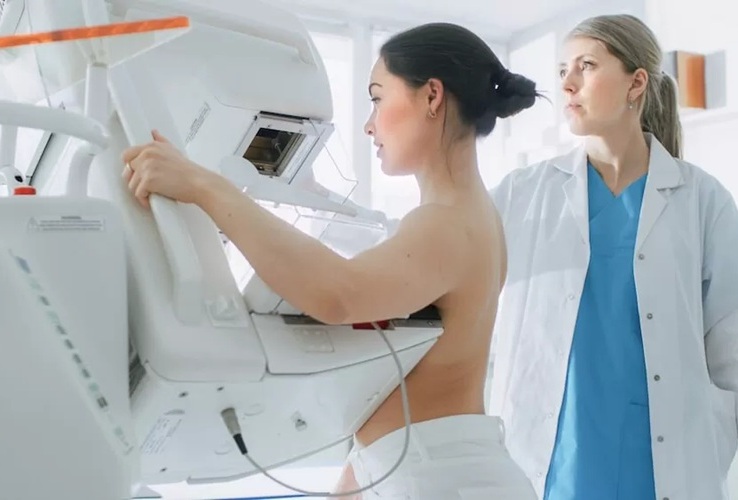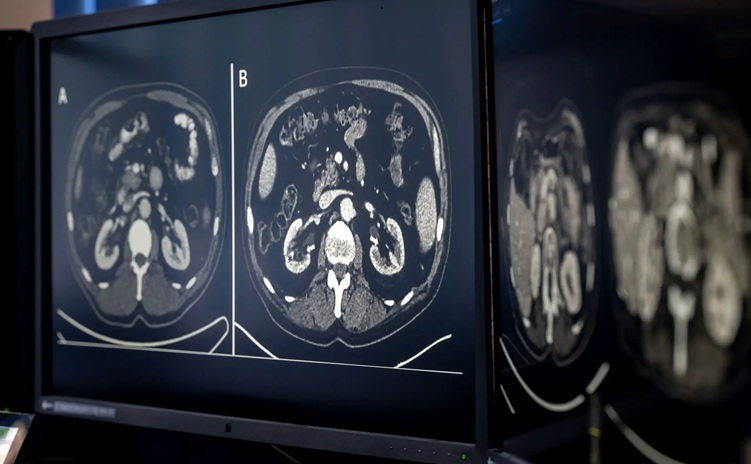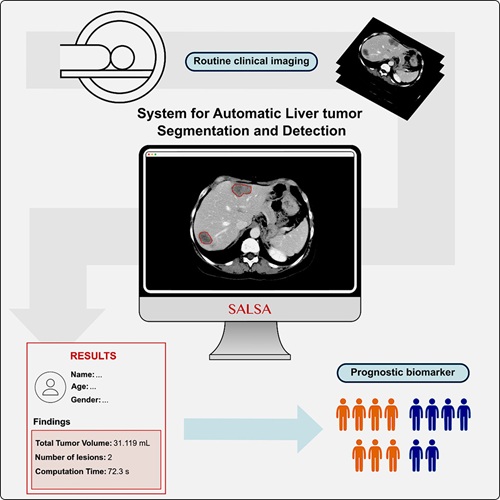Faster Treatment Choices for Bowel-Cancer Patients Using Tumor-Imaging Analysis Technology
|
By MedImaging International staff writers Posted on 25 Nov 2014 |
New imaging analysis technology helps hospitals make earlier and more accurate treatment decisions and survival assessments for patients with bowel cancer.
An innovative new medical imaging technology, TexRAD (Cambridge, UK), is an imaging risk stratification tool that analyses the texture of clinical diagnostic images for prognosis, risk, and treatment response. The tool analyses the texture of tumors, and has been shown in trials to enable early diagnosis of bowel-cancer patients not responding to the standard cancer therapy comparably better than other available tumor markers. Furthermore, the TexRAD markers showed the ability to evaluate at an early stage the probability of survival, differentiating patients who will have a good prognosis from those having poor prognosis.
Dr. Balaji Ganeshan, one of the University of Sussex (Brighton, UK) researchers whose research led to the development of the technology, said, “By using TexRAD to scan for subtle anomalies in a tumor’s texture, researchers have been able to spot more quickly when treatments are or are not working and adjust treatment accordingly. And because TexRAD simply provides an additional layer of software analysis of the MRI [magnetic resonance imaging] and CT [computed tomography] scans that already exist as part of routine clinical practice, it is noninvasive from the patient’s point of view and potentially cost-effective to the healthcare provider.”
The technology is being evaluated in a number of research institutions and university hospitals worldwide. Across two separate UK studies, researchers analyzed the tumors of 155 bowel-cancer patients. In a study at University College London Hospitals (UK), researchers examined baseline PET [positron emission tomography]-CT scans, i.e., those taken before treatment, and then followed up with the patients for an average of three years later. They found that analyzing the texture of the tumors in the first scans enabled them to effectively predict patient survival.
At Colchester General Hospital (UK), the researchers searched through MR scans captured both before treatment and six weeks after the patients had completed chemotherapy and radiotherapy, and found that the patients whose tumors were less heterogeneous (more uniform) in terms of texture parameters six weeks after treatment were more likely to survive longer.
Furthermore, researchers from the University of Rome (Italy) revealed that texture analysis provides useful imaging biomarkers that indicate how the tumor is responding to chemotherapy and radiotherapy. Andrea Laghi, a professor of radiology at the University of Rome, and lead investigator of the study, said, “The identification of new, accurate imaging biomarkers such as TexRAD analysis of MR images for early assessment of first-line cancer therapy response [predominantly to shrink the tumor before the main treatment] could be helpful in refining bowel-cancer patient management, providing a better targeting of preoperative therapy.”
The findings of the three studies will be presented to a wide international audience of radiologists, imaging scientists, healthcare providers, and industry at the 100th annual scientific meeting and exhibition of the Radiological Society of North America (RSNA), which will take place in Chicago (IL, USA), from November 30–December 5, 2014.
Related Links:
University of Sussex
University College London Hospitals
TexRAD
An innovative new medical imaging technology, TexRAD (Cambridge, UK), is an imaging risk stratification tool that analyses the texture of clinical diagnostic images for prognosis, risk, and treatment response. The tool analyses the texture of tumors, and has been shown in trials to enable early diagnosis of bowel-cancer patients not responding to the standard cancer therapy comparably better than other available tumor markers. Furthermore, the TexRAD markers showed the ability to evaluate at an early stage the probability of survival, differentiating patients who will have a good prognosis from those having poor prognosis.
Dr. Balaji Ganeshan, one of the University of Sussex (Brighton, UK) researchers whose research led to the development of the technology, said, “By using TexRAD to scan for subtle anomalies in a tumor’s texture, researchers have been able to spot more quickly when treatments are or are not working and adjust treatment accordingly. And because TexRAD simply provides an additional layer of software analysis of the MRI [magnetic resonance imaging] and CT [computed tomography] scans that already exist as part of routine clinical practice, it is noninvasive from the patient’s point of view and potentially cost-effective to the healthcare provider.”
The technology is being evaluated in a number of research institutions and university hospitals worldwide. Across two separate UK studies, researchers analyzed the tumors of 155 bowel-cancer patients. In a study at University College London Hospitals (UK), researchers examined baseline PET [positron emission tomography]-CT scans, i.e., those taken before treatment, and then followed up with the patients for an average of three years later. They found that analyzing the texture of the tumors in the first scans enabled them to effectively predict patient survival.
At Colchester General Hospital (UK), the researchers searched through MR scans captured both before treatment and six weeks after the patients had completed chemotherapy and radiotherapy, and found that the patients whose tumors were less heterogeneous (more uniform) in terms of texture parameters six weeks after treatment were more likely to survive longer.
Furthermore, researchers from the University of Rome (Italy) revealed that texture analysis provides useful imaging biomarkers that indicate how the tumor is responding to chemotherapy and radiotherapy. Andrea Laghi, a professor of radiology at the University of Rome, and lead investigator of the study, said, “The identification of new, accurate imaging biomarkers such as TexRAD analysis of MR images for early assessment of first-line cancer therapy response [predominantly to shrink the tumor before the main treatment] could be helpful in refining bowel-cancer patient management, providing a better targeting of preoperative therapy.”
The findings of the three studies will be presented to a wide international audience of radiologists, imaging scientists, healthcare providers, and industry at the 100th annual scientific meeting and exhibition of the Radiological Society of North America (RSNA), which will take place in Chicago (IL, USA), from November 30–December 5, 2014.
Related Links:
University of Sussex
University College London Hospitals
TexRAD
Latest Imaging IT News
- New Google Cloud Medical Imaging Suite Makes Imaging Healthcare Data More Accessible
- Global AI in Medical Diagnostics Market to Be Driven by Demand for Image Recognition in Radiology
- AI-Based Mammography Triage Software Helps Dramatically Improve Interpretation Process
- Artificial Intelligence (AI) Program Accurately Predicts Lung Cancer Risk from CT Images
- Image Management Platform Streamlines Treatment Plans
- AI-Based Technology for Ultrasound Image Analysis Receives FDA Approval
- AI Technology for Detecting Breast Cancer Receives CE Mark Approval
- Digital Pathology Software Improves Workflow Efficiency
- Patient-Centric Portal Facilitates Direct Imaging Access
- New Workstation Supports Customer-Driven Imaging Workflow
Channels
Radiography
view channel
Machine Learning Algorithm Identifies Cardiovascular Risk from Routine Bone Density Scans
A new study published in the Journal of Bone and Mineral Research reveals that an automated machine learning program can predict the risk of cardiovascular events and falls or fractures by analyzing bone... Read more
AI Improves Early Detection of Interval Breast Cancers
Interval breast cancers, which occur between routine screenings, are easier to treat when detected earlier. Early detection can reduce the need for aggressive treatments and improve the chances of better outcomes.... Read more
World's Largest Class Single Crystal Diamond Radiation Detector Opens New Possibilities for Diagnostic Imaging
Diamonds possess ideal physical properties for radiation detection, such as exceptional thermal and chemical stability along with a quick response time. Made of carbon with an atomic number of six, diamonds... Read moreMRI
view channel
New MRI Technique Reveals Hidden Heart Issues
Traditional exercise stress tests conducted within an MRI machine require patients to lie flat, a position that artificially improves heart function by increasing stroke volume due to gravity-driven blood... Read more
Shorter MRI Exam Effectively Detects Cancer in Dense Breasts
Women with extremely dense breasts face a higher risk of missed breast cancer diagnoses, as dense glandular and fibrous tissue can obscure tumors on mammograms. While breast MRI is recommended for supplemental... Read moreUltrasound
view channel
New Incision-Free Technique Halts Growth of Debilitating Brain Lesions
Cerebral cavernous malformations (CCMs), also known as cavernomas, are abnormal clusters of blood vessels that can grow in the brain, spinal cord, or other parts of the body. While most cases remain asymptomatic,... Read more.jpeg)
AI-Powered Lung Ultrasound Outperforms Human Experts in Tuberculosis Diagnosis
Despite global declines in tuberculosis (TB) rates in previous years, the incidence of TB rose by 4.6% from 2020 to 2023. Early screening and rapid diagnosis are essential elements of the World Health... Read moreNuclear Medicine
view channel
New Imaging Approach Could Reduce Need for Biopsies to Monitor Prostate Cancer
Prostate cancer is the second leading cause of cancer-related death among men in the United States. However, the majority of older men diagnosed with prostate cancer have slow-growing, low-risk forms of... Read more
Novel Radiolabeled Antibody Improves Diagnosis and Treatment of Solid Tumors
Interleukin-13 receptor α-2 (IL13Rα2) is a cell surface receptor commonly found in solid tumors such as glioblastoma, melanoma, and breast cancer. It is minimally expressed in normal tissues, making it... Read moreGeneral/Advanced Imaging
view channel
First-Of-Its-Kind Wearable Device Offers Revolutionary Alternative to CT Scans
Currently, patients with conditions such as heart failure, pneumonia, or respiratory distress often require multiple imaging procedures that are intermittent, disruptive, and involve high levels of radiation.... Read more
AI-Based CT Scan Analysis Predicts Early-Stage Kidney Damage Due to Cancer Treatments
Radioligand therapy, a form of targeted nuclear medicine, has recently gained attention for its potential in treating specific types of tumors. However, one of the potential side effects of this therapy... Read moreIndustry News
view channel
GE HealthCare and NVIDIA Collaboration to Reimagine Diagnostic Imaging
GE HealthCare (Chicago, IL, USA) has entered into a collaboration with NVIDIA (Santa Clara, CA, USA), expanding the existing relationship between the two companies to focus on pioneering innovation in... Read more
Patient-Specific 3D-Printed Phantoms Transform CT Imaging
New research has highlighted how anatomically precise, patient-specific 3D-printed phantoms are proving to be scalable, cost-effective, and efficient tools in the development of new CT scan algorithms... Read more
Siemens and Sectra Collaborate on Enhancing Radiology Workflows
Siemens Healthineers (Forchheim, Germany) and Sectra (Linköping, Sweden) have entered into a collaboration aimed at enhancing radiologists' diagnostic capabilities and, in turn, improving patient care... Read more




















